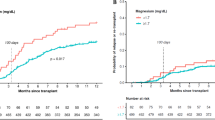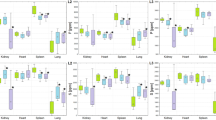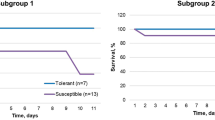Abstract
DURING the course of examinations on the effects of magnesium deficiency in rats1–4, tumours of the thymus developed in a few animals after prolonged periods of deficiency. This incidental finding stimulated a special investigation. Twelve male Holtzman Sprague–Dawley rats (110–125 g body-weight) were fed a magnesium-deficient diet3 for 95 days; twenty controls received the same diet to which was added 0.6 g of magnesium sulphate per 100 g of diet. Only five deficient rats survived until the end of the experiment. Convulsive seizures accounted for most deaths during the first weeks. Animals dying later showed extensive pleural effusion and ascitis; chronic lung disease with bronchiectatic abscesses was also observed. One rat died with a large thymus weighing 1.6 g after 75 days of magnesium deficiency. Microscopic examination revealed a total replacement of the normal architecture of the gland by sheets of large lymphoid cells. Another abnormal thymus was found at autopsy at the end of the experiment. In this case, thymic tissue had extended in all directions, infiltrating the base of the heart as well as the wall of the oesophagus; the same tissue had also grown retrosternally, reaching the diaphragm. Histologically the appearance was again characterized by a predominance of large lymphocytes or lymphoblasts with numerous mitotic figures (Fig. 1). Limited infiltration with similar cells was also seen in the portal spaces of the liver, in the kidney and in the adrenal cortex. The spleen and lymph nodes were not prominently enlarged and the blood was aleuksemic in both cases. The tumour was transplanted subcutaneously in Sprague–Dawley rats and grew rapidly, killing its host in 20–25 days. No tumour of the thymus was found in rats that were not magnesium-deficient.
This is a preview of subscription content, access via your institution
Access options
Subscribe to this journal
Receive 51 print issues and online access
$199.00 per year
only $3.90 per issue
Buy this article
- Purchase on SpringerLink
- Instant access to full article PDF
Prices may be subject to local taxes which are calculated during checkout
Similar content being viewed by others
References
Bois, P., Byrne, E. H., and Bélanger, L. F., Canad. J. Biochem. Physiol., 38, 585 (1960).
Bois, P., Gascon, A., and Beaulnes, A., Nature, 197, 501 (1963).
Bois, P., Brit. J. Exp. Path., 44, 151 (1963).
Bois, P., Un. méd. can., 93, 209 (1964).
Guérin, M., Tumeurs spontanées des animaux de laboratoire (Amédée Legrand et Cie, Paris, 1954).
Stoerk, H., Guérin, M., and Guérin, P., Bull. Ass. franç. Cancer., 33, 141 (1946).
Gross, L., Proc. Soc. Exp. Biol. and Med., 106, 890 (1961).
Jayson, G. G., Nature, 190, 144 (1961).
Jasmin, G., Rev. Canad. Biol., 22, 383 (1963).
Bélanger, L. F., Van Eerkel, G. A., and Jakerow, A., Science, 126, 29 (1957).
Author information
Authors and Affiliations
Rights and permissions
About this article
Cite this article
BOIS, P. Tumour of the Thymus in Magnesium-deficient Rats. Nature 204, 1316 (1964). https://doi.org/10.1038/2041316a0
Issue date:
DOI: https://doi.org/10.1038/2041316a0
This article is cited by
-
Protective effect of magnesium on DNA strand breaks induced by nickel or cadmium
Cell Biology and Toxicology (1994)
-
Effects of essential divalent metals on carcinogenicity and metabolism of nickel and cadmium
Biological Trace Element Research (1987)
-
Magnesium (and trace substance) deficiencies in the pathogenesis of cancer
Biological Trace Element Research (1979)
-
Localized, multiform, sub-periosteal hyperplasia and generalized osteomyelosclerosis in magnesium-deficient rats
Calcified Tissue Research (1972)
-
Magnesium metabolism
Ergebnisse der Physiologie Biologischen Chemie und Experimentellen Pharmakologie (1967)



